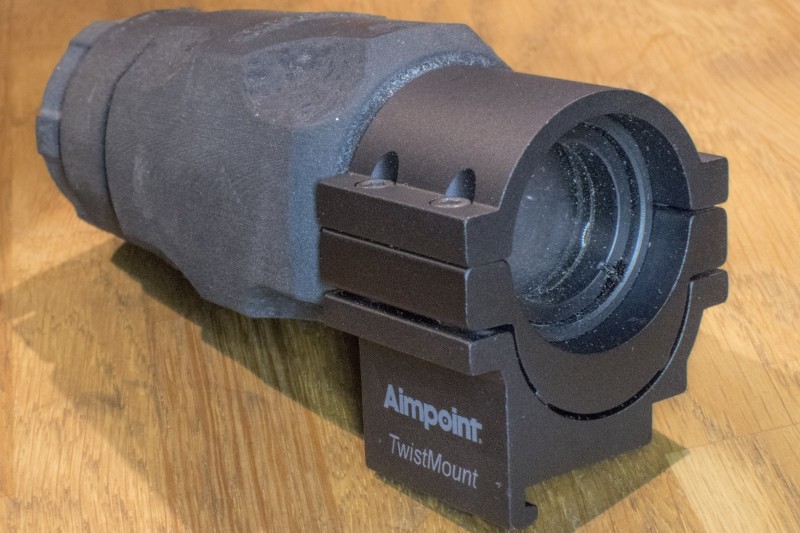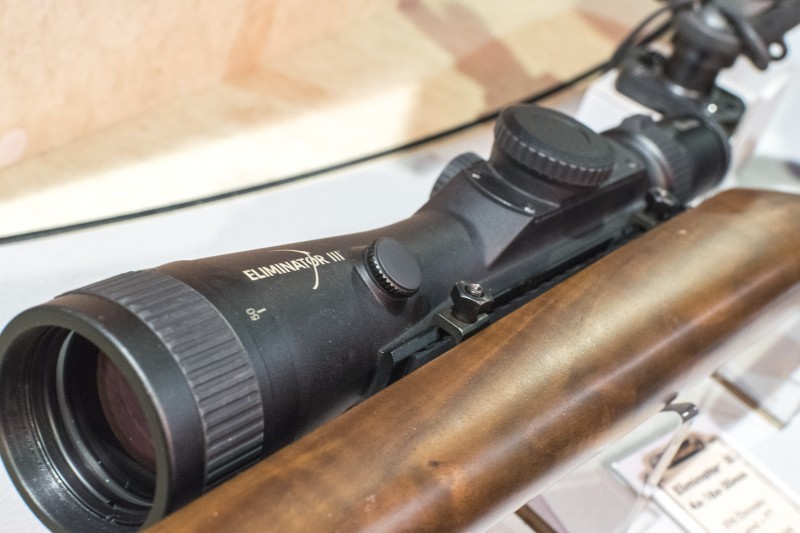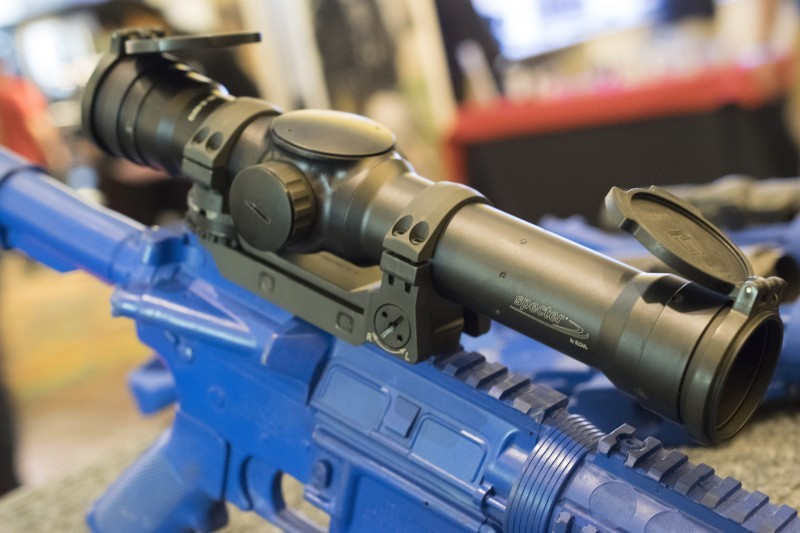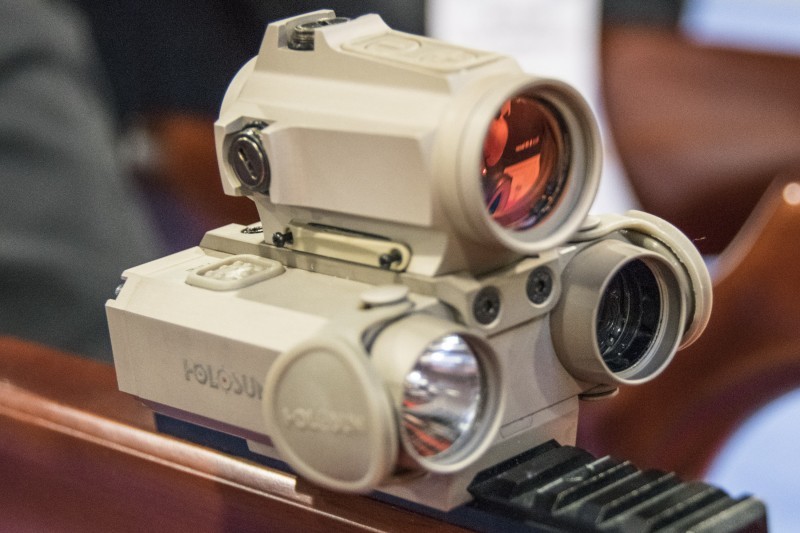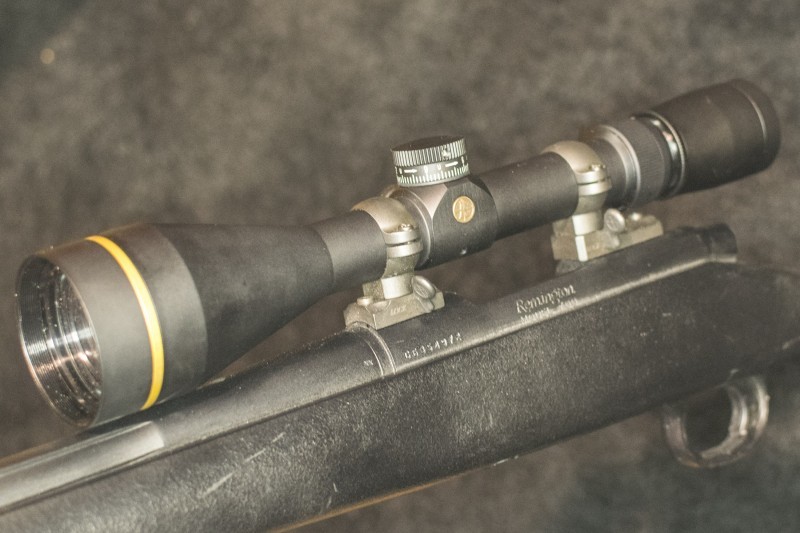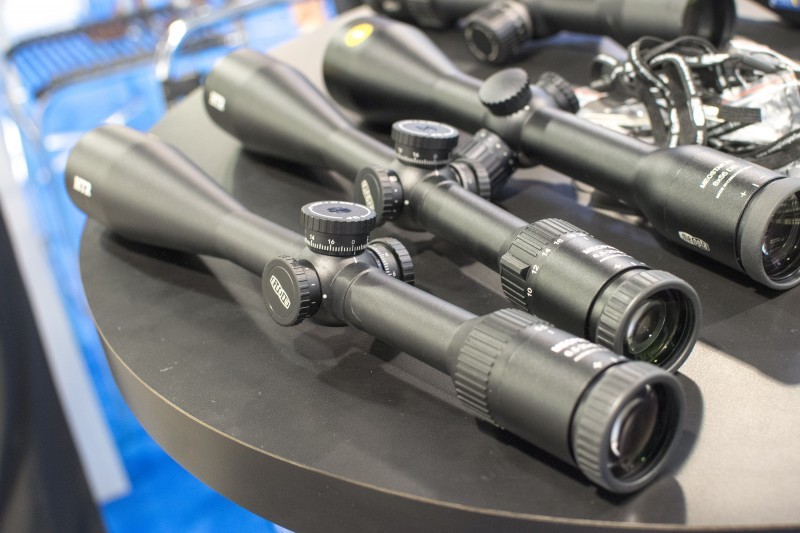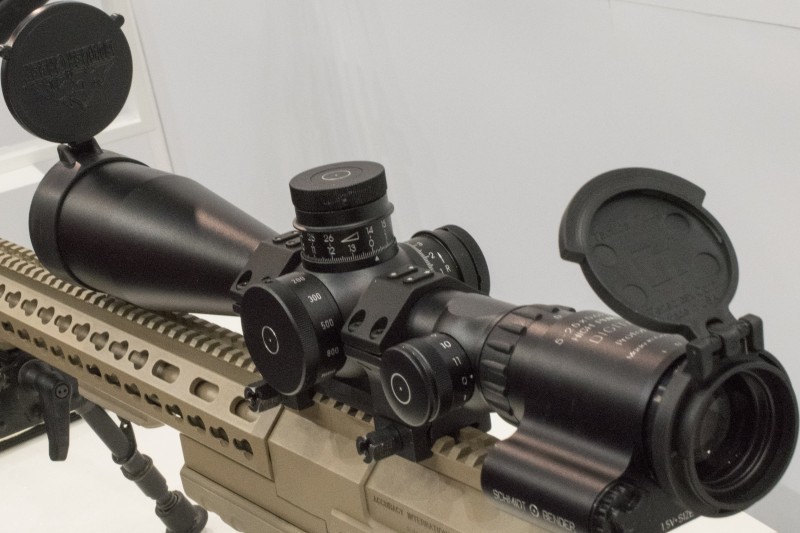Firearms are a mature technology. Shooters are unlikely to see enormous technological leaps in the basic form or function of modern small arms. Capacity, caliber and weight will all be further optimized, but until solid projectiles are replaced with lasers, firearms will retain their current form.
The same cannot be said of optics, however.
Clarity and light reception have grown exponentially since the first optical gunsight helped a shooter place rounds on a distant target. Nowhere is this quantum leap more evident than at the annual Shooting, Hunting and Outdoor Trade Show, where countless vendors showcase thousands of upcoming products each year. This year, in particular, saw an explosive growth in new optics ranging from thermal and reflex sights to prismatic and traditional magnified telescopic options. There were nearly too many to count; thankfully we’ve compiled the top new choices from the 2016 SHOT Show.
AimPoint Inc.
AimPoint has a reputation in the U.S. as a military or law enforcement optics provider. However, this Swedish manufacturer is seen as primarily a hunting accessory maker in its home country and across Europe. Overseas it’s not uncommon to see AimPoint reflex sights on hunting rifles, revolvers and shotguns alike. Looking to better capitalize on this portion of the U.S. market, AimPoint announced the introduction of a new campaign and product line dedicated to North American hunters.
The first product the company introduced in this new line is the 3X-C, a standalone magnifier designed to function with AimPoint reflex sights. When used in conjunction with an AimPoint T-2 or PRO/ACO optic, the 3X-C converts the unmagnified reflex sight into a telescopic one. While AimPoint has offered magnifiers in the past, they lacked the adjustable diopter setting of the new models and were prohibitively expensive. The new 3X-C should be available early April 2016, with an MSRP of $307.
AimPoint hasn’t abandoned its military or law enforcement clients either, which is why the company has introduced a new 6x magnifier imaginatively named the 6xMAG-1. Retailing for nearly 300 percent more than its civilian 3x magnifier, the new 6xMAG-1 allows AimPoint reflex sights to function in the same role as fixed magnification optic like an ACOG, with more operational flexibility to function as a standard reflex sight. The 6xMAG-1 doesn’t have a concrete launch date yet, but AimPoint is looking to launch it sometime this summer for around $900.
Burris
Burris has enjoyed a dedicated group of fans and consumers thanks to its affordable, quality optics and binoculars. Straddling the fence in terms of quality between super high-end optics makers and budget-priced throwaway imports, Burris is like Goldilocks’ favorite bed — just right.
Even still, they’re not satisfied to simply remain the go-to brand for hunters, shooters and sportsman on a budget. They also want to capture the higher-end market, without the cost normally associated with premium brands. One of its latest attempts involves a few crucial upgrades to an existing deluxe optic: the X96 Eliminator III.
If that wasn’t already a mouthful, to be more precise, it’s the X96 Eliminator III with wind and PTT. The latter two additions signifying the presence of an on-scope wind meter and laser range finder. The really cool part? Both displays are integrated into the reticle itself, so shooters don’t have to come off the scope to read the wind or drop on a target.
Additionally, the Eliminator reticle allows shooters to enter their specific load and when combined with proper windage and ballistic coefficient, displays precisely where a shooter needs to aim to successfully engage a given target.
The Eliminator is available in several different reticle patterns including Horus H591, Mil Dot and Ballistic Circle Dot. So no matter what a shooter prefers, they can still utilize the new Burris optic without having to learn a new system.
Elcan
Canadian optics maker Elcan is the optics branch of military tech firm, Raytheon Inc. Their optics are known for their ultra clarity and durability in worldwide militaries. American soldiers often encounter Elcan’s fixed magnification LMG sight, the M145 atop the M240B machine gun. On that platform, its 7.62x51mm BDC allows gunners to effortless drop lethal rounds on top of enemy combatants.
The other sights the company is known for are its Specter DR series of prismatic gunsights. These utilize a rotating prism to allow the user to toggle between two magnifications at the flip of an exterior lever. While popular with special forces units, civilians often find their limited magnification and high price difficult to rationalize.
Seeking to expand its customer base, Elcan showcased its new three-step prismatic scope that allows shooters to choose either three, six or nine power magnification. Named the Specter TR 1-3-9x, the optic that first premiered in 2014 is now seeing increased production and availability to the civilian, military and law enforcement market. In that market it fits the unique role of being a perfect choice for shooters looking for variable magnification without sacrificing light reception or image clarity.
HoloSun
HoloSun is a Chinese optics maker that specializes in tactical, affordable alternatives to high-end military gear. The quality of its products lies somewhere between NcStar and Tasco — so not terribly durable. Still, the company can’t be faulted for not innovating as HoloSun showcased more than half a dozen new optics at SHOT Show 2016.
One that caught my eye is HoloSun’s new IR laser, tactical light reflex sight combo. Yes, it really is all three of these things. HoloSun says it’s not available yet, but will enter production soon and be available in two finishes: black and FDE. No specs were given on the output or battery life of any of the three devices, but they all appear to utilize independent power switches.
Additionally, the Holosun triple device seems to utilize two different power sources: one for the IR laser, tactical light combo and another for the reflex sight itself. Despite being a clone and hybrid of pricey American and European products, the new device still has a steep estimated MSRP of around $1,300.
While certainly not a bad price for a solid tactical light, IR laser and red dot separately, as a combined unit from a manufacturer that’s relatively new to the market, it’s unclear what the long-term durability might be. But it’s cool to see a company rolling together all this technology into one optic that takes up less real estate on a rifle than three separate units.
Leupold
The old “ring o’ gold” was still alive and kicking at this year’s SHOT Show. As in past years, Leupold arrived in Las Vegas with yet another strong product lineup. While not as varied or innovative as other smaller optic makers’ offerings, the new products unveiled at the show demonstrate a solid business sense and perhaps a conservative market strategy. While possibly the antithesis of “sexy,” the company’s strategy, like its products, are rock solid reliable and pragmatic.
Rather than design an all new optic from the ground up, Leupold instead sought to offer existing successful products in slight variations — though not simply on a whim, but as a response to consumer demands. For instance, its new VX-3i CDS scope shares everything down to the outer finish with the older model, except it includes Leupold’s new Wind-Plex reticle and new Custom Dial System turrets.
This new crosshair type is a modification of the original Duplex reticle introduced by Leupold in 1962. It features horizontal ticks one MOA apart, divided by a single narrow vertical line. This permits rapid, accurate shot placement with holdover options for windy conditions.
And the CDS turrets can be adjusted to match a specific bullet grain and caliber, giving shooters the confidence and capability necessary to engage distant targets with deadly precision.
Meopta
Relative newcomer Meopta continues to shatter expectations with its MeoPro and ZD series of rifle scopes. In fact, one of the worst kept secrets of the industry is how many high-end scope brands utilize Meopta components in their mid-level product lines.
With some of the brightest optics on the market, it’s no wonder Meopta is gaining a steady foothold with hunters in the U.S. Following in this tradition, Meopta announced its newest addition to the company’s optics lineup: the MeoPro 6.5-20x50 HTR.
The HTR portion of the lengthy title stands for “Hunt / Tactical / Range” describing the telescopic sight’s multi-role function. The new HTR optic is available in four different reticle patterns and features the MeoBright ion-assisted lens coating that gives the Czech optics such incredible light reception. It also features oversized turrets with audible “clicking” .25 MOA adjustments for a precise, repeatable zero.
Zeiss
German optics are known for their quality and clarity, and Zeiss’s new Victory V8 1.8-14x50 riflescope is no exception. Zeiss incorporates glass from one of the finest glassmakers on the planet, SCHOTT Advanced Optics. Using SCHOTT’s HT, or high transmission glass, the Victory V8 produces 92 percent light transmission, extending hunting time by up to 30 minutes.
Additionally, the new optic’s astoundingly wide range of magnification allows for use up close at 1.8 times magnification, while still being able to reach out and engage distant targets with a 14 times magnification setting. The 1.8x did have some distortion/fisheye, but it was still manageable.
Also, unlike many inexpensive brands of high magnification optics that suffer parallax issues when fully zoomed, the V8 incorporates a parallax adjustment knob allowing shooters to dial in the scope to their preference.
One of the more advanced features on the new V8 is the motion sensor inside the optic itself. This is tied directly to the illuminated dot’s power control, allowing the optic to illuminate when the rifle is shouldered while saving power when not in use. Shooters who wish for the illumination to either always be on or off, can choose so using the same control knob near the eyepiece.
Schmidt & Bender
Founded in 1957 by Helmut Schmidt and Helmut Bender, Schmidt & Bender has been making top tier optics for the military and civilian industry for decades. While not a household name in the U.S., more people have seen and handled its products than realize it; after all, Schmidt & Bender made the integral rifle scope seen on the Austrian Steyr AUG bullpup military rifle.
Though Schmidt & Bender does much more than simply make fixed magnification combat sights for infantry, it’s also the go-to optic for ultra high-end precision riflemaker Accuracy International. Schmidt & Bender sights are also the optic of choice for Heckler & Koch’s famous PSG-1. Needless to say, if AI and H&K promote your product on their highest-end rifles, you’re doing something right.
So naturally, when S&B wants to capture even more of the high-end long range market, it simply modifies one of the company’s already outstanding designs to appeal to even more shooters. In this case, S&B takes the 5-45x56 PM II scope used by U.S. special operations command and adds the capability to accept digital instrument input — namely, windage and range.
The result?
The 5-25x56 PM II Digital BT features a 34mm tube, 5 to 25 times magnification and is a first focal plane 56mm objective lens scope. Featuring a 5.3m field of view and 90 percent light transmission, the illuminated scope is ideal for long range precision engagements. This is evident not only because of the high magnification level, but also in the wide range of elevation and windage adjustments — 14 MOA of windage and 64 minutes of elevation adjustment.
Trijicon
Anyone who’s paid even the slightest amount of attention to the past two decades has seen one of Trijicon’s ACOGs in action. These diehard fixed magnification optics are as common on U.S. service rifles as iron sights are — for good reason. The ingenious BDC crosshair and no-batteries-required tritium-illuminated reticle give soldiers a tangible edge over adversaries equipped with iron-sighted firearms.
Though not as many shooters realize it, Trijicon also manufacturers quality hunting and sporting optics. In this same vein, Trijicon unveiled two new non-ACOG products at this year’s SHOT Show.
The most talked about addition to its lineup is the MRO. The three MOA dot reflex sight looks like a miniature ACOG but is a true, unmagnified reflex sight. What separates the MRO from other reflex sights like Trijicon’s RMR, is it’s 1x25mm objective lens. This opens up the shooter’s field of view, preventing him from getting stuck with tunnel vision.
The MRO features multiple night-vision-compatible brightness settings, and with the brightness set to five, has an impressive five-year battery life. All the MRO’s windage and elevation controls are inset to prevent accidental shifts when dropped or banged on objects.
The other new product from Trijicon is a new AccuPoint scope, the 1-6x24. Featuring the same iconic adjustment wheel and super bright tritium-illuminated reticle, this new AccuPoint makes a great optic for shooters who love their ACOG but want something more appropriate for hunting.
While the optics market continues to evolve both for civilian and military consumers, the end result is the same: an increasingly crowded market full of options for every budget. While initially overwhelming, the competitive nature of this market ensures an abundance of high quality products will move off store shelves for the foreseeable future.

